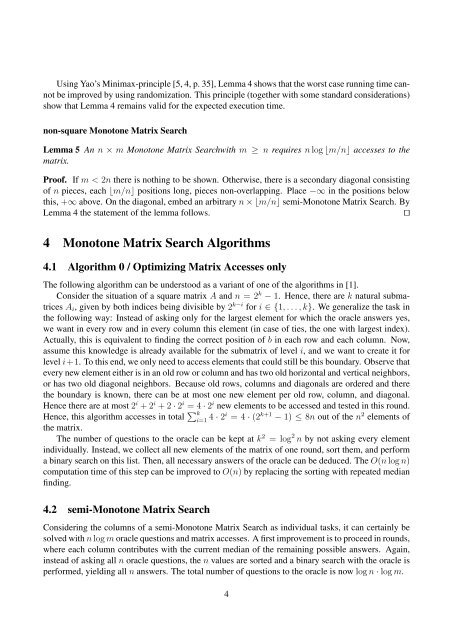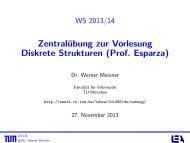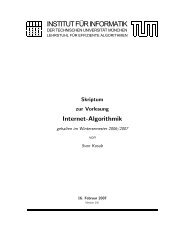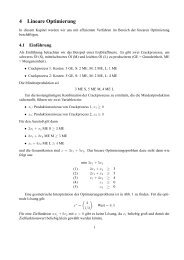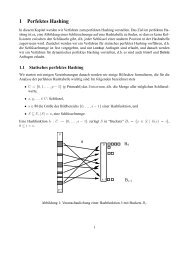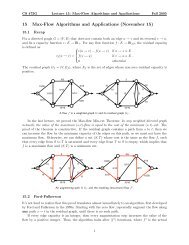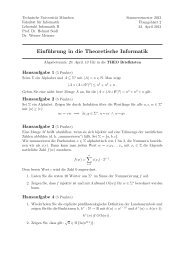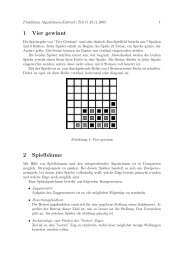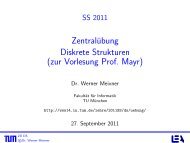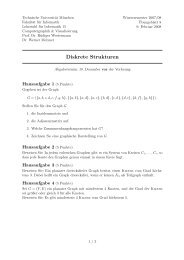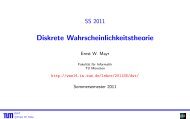ABCDE FGHIJ KLMNO
ABCDE FGHIJ KLMNO
ABCDE FGHIJ KLMNO
- No tags were found...
You also want an ePaper? Increase the reach of your titles
YUMPU automatically turns print PDFs into web optimized ePapers that Google loves.
Using Yao’s Minimax-principle [5, 4, p. 35], Lemma 4 shows that the worst case running time cannotbe improved by using randomization. This principle (together with some standard considerations)show that Lemma 4 remains valid for the expected execution time.non-square Monotone Matrix SearchLemma 5 An n × m Monotone Matrix Searchwith m ≥ n requires n log ⌊m/n⌋ accesses to thematrix.Proof. If m < 2n there is nothing to be shown. Otherwise, there is a secondary diagonal consistingof n pieces, each ⌊m/n⌋ positions long, pieces non-overlapping. Place −∞ in the positions belowthis, +∞ above. On the diagonal, embed an arbitrary n × ⌊m/n⌋ semi-Monotone Matrix Search. ByLemma 4 the statement of the lemma follows.⊓⊔4 Monotone Matrix Search Algorithms4.1 Algorithm 0 / Optimizing Matrix Accesses onlyThe following algorithm can be understood as a variant of one of the algorithms in [1].Consider the situation of a square matrix A and n = 2 k − 1. Hence, there are k natural submatricesA i , given by both indices being divisible by 2 k−i for i ∈ {1, . . . , k}. We generalize the task inthe following way: Instead of asking only for the largest element for which the oracle answers yes,we want in every row and in every column this element (in case of ties, the one with largest index).Actually, this is equivalent to finding the correct position of b in each row and each column. Now,assume this knowledge is already available for the submatrix of level i, and we want to create it forlevel i+1. To this end, we only need to access elements that could still be this boundary. Observe thatevery new element either is in an old row or column and has two old horizontal and vertical neighbors,or has two old diagonal neighbors. Because old rows, columns and diagonals are ordered and therethe boundary is known, there can be at most one new element per old row, column, and diagonal.Hence there are at most 2 i + 2 i + 2 · 2 i = 4 · 2 i new elements to be accessed and tested in this round.Hence, this algorithm accesses in total ∑ ki=1 4 · 2i = 4 · (2 k+1 − 1) ≤ 8n out of the n 2 elements ofthe matrix.The number of questions to the oracle can be kept at k 2 = log 2 n by not asking every elementindividually. Instead, we collect all new elements of the matrix of one round, sort them, and performa binary search on this list. Then, all necessary answers of the oracle can be deduced. The O(n log n)computation time of this step can be improved to O(n) by replacing the sorting with repeated medianfinding.4.2 semi-Monotone Matrix SearchConsidering the columns of a semi-Monotone Matrix Search as individual tasks, it can certainly besolved with n log m oracle questions and matrix accesses. A first improvement is to proceed in rounds,where each column contributes with the current median of the remaining possible answers. Again,instead of asking all n oracle questions, the n values are sorted and a binary search with the oracle isperformed, yielding all n answers. The total number of questions to the oracle is now log n · log m.4


